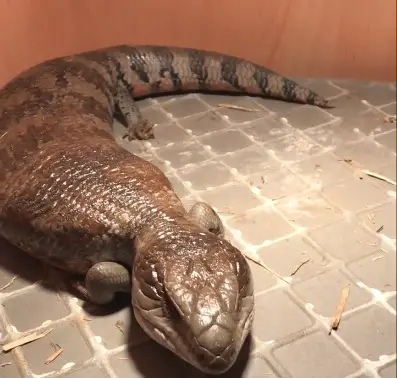New environments can cause stress to blue tongue skinks. Therefore, whether you acquire yours from the wild or captivity, you will need to tame your blue tongue skink.
However, wild-caught blue tongue skinks are challenging to handle. It is because, in captivity, they quickly get stressed.
Therefore, wild BTSs can get defensive and aggressive. This article will help you understand their behavior, tame, and bond with new and mad blue tongue skinks.
Contents
Does Blue Tongue Skink Get Aggressive?

Blue tongue skinks are not aggressive. However, if they feel threatened, they can get defensive. When you introduce a blue tongue skink in a new environment, it might see you as a threat. Thus, it will occasionally be aggressive.
Blue tongue skinks can bite if you try to handle them at this time. However, their bite is not poisonous, and so you should not be overly scared. Even so, their bite can be painful.
For these reasons, it is critical to understand your blue tongue skink behavior to prevent injuries.
New to blue tongue skink? Check out the blue tongue skink care sheet now! We had listed out all the things you need to know about blue tongue skinks as pets. Check it now!
Blue tongue skink body language behavior
- Short snorting and huffing show the BTS annoyance.
- Waggling/long huffs and body tilt shows aggressiveness.
- Opening their mouth and sticking out their tongue tells they are defensive.
Pregnancy of Female Blue tongue skink

(Source: Mr Slytherin YouTube)
Blue tongue skinks during pregnancy suffer from severe mood swings. And, they can overly get aggressive towards the male during mating. Thus, if you want to mate them, and the female is excessively pushy, the female may be pregnant.
In this case, you should take the male out to prevent injuries.
It would be best if you did not try to handle the female blue tongue skinks when they are pregnant. They are usually irritable and aggressive, and they are highly likely to bite you.
How to Tame a New Blue Tongue Skink?
You can tame a new blue tongue skink using these three steps;
- Be patient with it and give it time to habituate.
- Start approaching the tank regularly, talk, and offer treats to your BTS.
- Start to handle your blue tongue skink.
- Be Patient with It and Give It Time to Habituate
New environments can cause stress to your blue tongue skink. Therefore, it is critical to give it enough time to familiarize itself with its new home. There are several steps you can consider to help your blue tongue skink settle down quickly.
These include;
Prior tank set up
Before you even bring in a blue tongue skink into your home, the first step should be to prepare its new habitat (tank). You should include at least two hideouts for your pet. When you introduce blue tongue skinks in a new environment, they are likely to spend most of their time hiding.
Providing hiding places for your BTS during their first weeks will help them feel secure and reduce stress.
Don’t handle your blue tongue skinks for at least 10-14 days.
When you introduce blue tongue skinks into a new habitat, they feel insecure and stressed. For these reasons, you should only handle them when necessary.
Also, it would help if you did not introduce any other pet during this stage. Other pets can only add stress to your blue tongue skink and delay the taming period.
- Start Approaching the Tanks Regularly, Talking, and Offering Treats to Your BTS
After 2- 3 weeks of introducing the BTS to his new home, the next step will be to approach it regularly. Regular visits and talks will help your BTS to familiarize himself with you.
During this period, you should also ensure that you talk and offer him a treat. The talk will help him recognize your voice while treating him will help him to trust you.
The main reason why blue tongue skinks hide in their new environments is because they feel uncomfortable and insecure. Hence, your central role when taming them should be to gain their trust and make them comfortable.
New to blue tongue skink? Check out the blue tongue skink care sheet now! We had listed out all the things you need to know about blue tongue skinks as pets. Check it now!
- Start Handling your BTS
When blue tongue skinks start to feel secure and comfortable, they stop hiding regularly. Instead, they begin to approach every time they hear your voice because they will be expecting a treat. At this stage, you can now start to handle them.
However, they might still show aggressive behavior during this stage. Therefore, you should protect yourself as blue tongue skinks are likely to bite.
Here are some tips to help you easily handle them
- Wear welding gloves
Blue tongue skink bite can be painful. Therefore, you should be cautious to prevent injuries. Also, gloves will help you handle your pet with confidence.
- Handle your BTS well
The best way to handle your BTS is to hold his chest while supporting his front and back legs and letting the tail rest on your arms. Grabbing or wrong handling of your pet can make him insecure and provoke his aggressive behavior.
- Slowly introduce him to areas with few people and noise.
For your pet to familiarize himself with other people and your daily routine life, it is necessary to introduce him to other family members. It would also help if you took him to noisy places to get used to the daily commotion.
How to Tame a Mad Blue tongue Skink?
Taming a mad blue tongue skink can be challenging, the best way to tame them is by being more patient with them. A mad blue tongue skink will show it by trying to huff at you whenever you want to approach him.
Mad blue tongue skinks tend to hide most of the time. Thus, you might consider covering the sides of the mad blue tongue skink’s tank with dark clothes.
However, it would be best if you did not keep your pet in isolation for long, as it might get used to loneliness.
Taking your blue tongue skink bit by bit will help you to gain its trust easily and quickly. Therefore, if you cover your BTS tank with dark clothes, you should slowly uncover each side. This way, you will help the skink to get used to the light and exposure bit by bit.
Also, you can offer treats to a mad BTS more often. By doing this, you will help him to see you as a friend rather than a threat.
Conclusion
Taming your blue tongue skinks is a long process that needs patience. Therefore, you should not be in a hurry to tame yours. It is easy to tame BTS you obtain from captivity than those from the wild.
However, if you get yours from the wild, you can use the same tips to tame them. But, it is worth noting that it might be impossible to fully tame a wild BTS, especially if you acquire them as adults.
